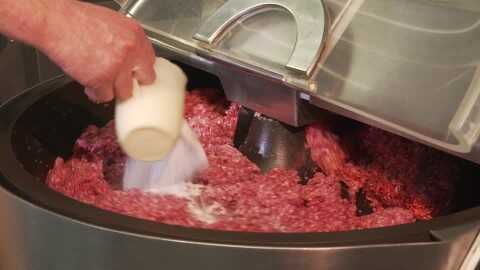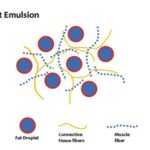
A emulsão cárnea consiste na ligação(suspensão estável) da água e gordura com a proteína da carne. Normalmente a água e a gordura não conseguem formar ligações, e, para que seja possível realizar essa ligação é preciso utilizar um agente emulsificante. A proteína da carne serve como o “agente emulsificante”, ou estrutura que torna possível a estabilização desses 3 componentes em uma massa lisa e uniforme. A miosina, proteína mais abundante na carne, é a princípal encapsuladora das particulas de gordura e água.
Exemplos de produtos emulsionados são as salsichas, patês, mortadelas, algumas linguiças calabresa dentre outros muitos produtos.
Há três estágios na formação da emulsão, que são os pontos chaves para a retenção de água.
Estágios da emulsão cárnea
- Extração e dilatação da proteína;
- Encapsulamento da gordura ou formação da emulsão;
- Formação do gel estável na cocção.
A extração e dilatação da proteína é realizada com o processamento ou corte fino da carne utilizando lâminas de corte em um cutter ou processador de alimentos. Durante a extração são adicionados ingredientes funcionais como o sal e os fosfatos, que ajudam na solubilização ou capacidade da carne em reter água, que é a dilatação e aprisionamento da água. Os fosfatos aumentam o pH da formulaçao incrementando as cargas negativas que ajudam na retenção da água.
Assim que a carne foi processada e a proteína extraída é adicionada a gordura, que fica retida entre a proteína, orientando a estrutura e abrindo espaço para a adição e retenção de água, geralmente adicionada em forma de gelo moído. O ponto crítico deste estágio é a temperatura. É recomendado que a emulsão cárnea não ultrapasse os 10°C. Aquecimento fará com que a gordura amoleça e impedirá que a proteína consiga encapsular as partículas de gordura.

A última etapa é a cocção da massa até a temperatura interna de 73°C para que seja formado um gel estável e atinja a temperatura de segurança.
Fatores que interferem na emulsão cárnea
Qualidade da água
É importante utilizar uma água filtrada e livre de impurezas. A água ideal tem baixas concentrações de cálcio (Ca+2) e magnésio (Mg+2).
Funcionalidade da proteína
A actina e a miosina são proteínas da carne solubilizáveis em sal com áreas hidrofílicas para reter água e área hidrofóbicas, que retém gordura e outros compostos não polarizados. Como a polarização é importante na retenção de água então o pH da carne tem grande relevância. Utilize uma fonte de proteína de boa qualidade que tenha sido processada de forma correta desde o abate do animal, isso garantirá uma boa capacidade de retenção de água.
Temperatura de processamento
É preciso manter a massa gelada enquanto é trabalhada pois o calor amolece a gordura e impede sua retenção pela proteína. Conforme recomendado por MACKENZIE(1966) a temperatura deve ficar abaixo de 15°C.
Proporção balanceada – Água, gordura e proteína em quantidades corretas proporcionam uma melhor emulsão. A proteína é o que retém água, então é importante utilizar uma quantidade mínima de 16% de proteína magra. Quanto mais proteína, mais espaço para a gordura e a água estará disponível, garantindo assim uma melhor emulsão.
Ingredientes – A escolha correta e qualidade de todos os ingredientes é muito importante para a habilidade de manter a emulsão no processamento e cocção. O sal e os fosfatos são os ingredientes funcionais mais importantes de uma emulsão cárnea. Uma concentração de sal entre 1.5 e 2.0 porcento é recomendada para um bom sabor e boa viscosidade. O sal reage com as cargas da carne aumentado os espaços para a retenção de água, o que é chamado de solubilização da proteína. Os fosfatos aumentam o pH da carne ajudando também na retenção de água. Proteínas vegetais ou de leite também são muito utilizadas para aumentar a capacidade de retenção de água, principalmente em produtos com baixo teor de proteínas.
Processo e sequência – O momento correto de adicionar os ingredientes e iniciar os processos afeta o desempenho da emulsão. ACTON e SAFFLE(1969) obtiveram um aumento da capacidade de emulsionar gordura da carne bovina com a adição de sal comum e gelo 12-24 horas antes da elaboração da emulsão.
Cocção – A retenção de água está ligada ao correto método, tempo e temperatura do processo de cocção. A cocção geralmente é feita em temperatura próxima a 80 graus.
Referências:
– https://meatsci.osu.edu/node/130
– http://www.meatingplace.com/Industry/TechnicalArticles/Details/68658
– http://www.scielo.br/pdf/aesalq/v31/23.pdf




Olá, estou usando leite em pó para emulsificar, porém comprei de vocês o imulsificador, osso substituir tranquilos e qual a porcentagem para linguicinhas artesanais
Pode substituir sim, use 1% do mix emulsificador sobre o peso da massa cárnea.
Oi Sr Cláudio. Muito bom dia! Onde posso encontrar emulsificante de carne em Roraima? No aguarde! Obrigado!!!!
Bom dia. O amigo teria como me informar onde comprar emulsificante de carne , aqui em b Oi a vista RR?
Oi Adalto, em Roraima não sei te indicar. Só online mesmo: https://charcutaria.org/produto/emulsificante-estabilizante-carneo-embutidos-rendimento/
Olá,
o uso do Emulsificante na linguiça, pode perder a característica da linguiça de ser artesanal ou não tem nada haver?
Oi Claudio, artesanal representa produtos elaborados de forma não industrial, geralmente seguindo uma receita tradicional/regional. Do meu ponto de vista o uso de aditivos não altera essa definição. Para a comercialização as linguiças precisam ter o sal de cura, por exemplo, então mesmo sendo um produto artesanal ele tem que conter esse aditivo. Pesquise sobre o selo arte ou o sisbi em seu município/estado, os órgãos responsáveis por estes selos podem te orientar de forma precisa.
Olá!
Sigo o canal a algum tempo e quando possível tento reproduzir algumas das receitas postadas. Uma em especial que gostei muito foi o preparo da salsicha, usei o multi processador… consegui fazer as salsichas, mas pensei que perderia o eletrodoméstico. Quero fazer salsichas novamente, mas poderia me informar se existem equipamentos mais potentes para emulsificar de 5 até 10 k de carnes?
Agradeço a atenção e continue com o excelente trabalho.
Oi Helder, há processadores tipo “cutter” de diversas marcas, desde pequenos que funcionam como os processadores só que maiores e mais potentes até os industriais rotativos de grande porte.
Olá ! Um cutter desse seria adequado para uma pequena produção com boa emulsificação ?
Modelo
Skymsen cr 4l
Oi Fábio, nunca testei esse cutter mas aparentemente sim pelas características tem tudo para gerar uma boa emulsão. Questine o fabricante sobre esse uso em específico, eles podem ter algumas dicas. De modo geral siga os padrões de temperatura baixa, acrescente uma boa quantidade de gelo moído e use um mix emulsificante/rendimento. Salgue a carne um dia antes. Moa uma ou duas vezes e só então processe no cutter. Isso vai ajudar muito no sucesso da emulsão.
Obrigado pelas dicas, abraços 🙂